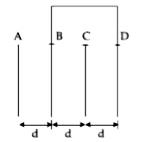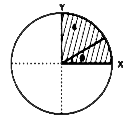The difference between bond orders of CO and NO⊕ is x2 where x = _________ .
(Round off to the Nearest Integer)
The correct Answer is:0
To solve the problem, we need to find the bond orders of carbon monoxide (CO) and the nitric oxide ion (NO^+), and then calculate the difference between these bond orders.
1. Determine the Total Number of Electrons:
- CO consists of Carbon (C) and Oxygen (O).
- Carbon (C) has 6 electrons.
- Oxygen (O) has 8 electrons.
- Total electrons in CO = 6 + 8 = 14 electrons.
- NO^+ consists of Nitrogen (N) and Oxygen (O).
- Nitrogen (N) has 7 electrons.
- Oxygen (O) has 8 electrons.
- Since NO^+ has a positive charge, it loses one electron.
- Total electrons in NO^+ = 7 + 8 - 1 = 14 electrons.
2. Molecular Orbital Configuration:
- Both CO and NO^+ have 14 electrons, so their molecular orbital configurations will be similar.
- The filling of molecular orbitals follows this order:
- σ(1s)², σ*(1s)², σ(2s)², σ*(2s)², σ(2p_z)², π(2p_x)², π(2p_y)²
- For both CO and NO^+, the configuration will be:
- σ(1s)², σ*(1s)², σ(2s)², σ*(2s)², σ(2p_z)², π(2p_x)², π(2p_y)²
- This accounts for 10 bonding electrons and 4 antibonding electrons.
3. Calculate Bond Order:
- The bond order (BO) is calculated using the formula:
Bond Order=Number of electrons in bonding MOs−Number of electrons in antibonding MOs2
- For both CO and NO^+:
- Number of bonding electrons = 10
- Number of antibonding electrons = 4
- Bond Order = 10−42=62=3
4. Calculate the Difference in Bond Orders:
- Bond Order of CO = 3
- Bond Order of NO^+ = 3
- Difference in bond orders = 3−3=0
5. Relate the Difference to x:
- According to the problem, the difference in bond orders is given as x2.
- We have found that the difference is 0, so:
0=x2
- Solving for x gives:
x=0×2=0
Final Answer:
The value of x is 0.
- CO consists of Carbon (C) and Oxygen (O).
- Carbon (C) has 6 electrons.
- Oxygen (O) has 8 electrons.
- Total electrons in CO = 6 + 8 = 14 electrons.
- NO^+ consists of Nitrogen (N) and Oxygen (O).
- Nitrogen (N) has 7 electrons.
- Oxygen (O) has 8 electrons.
- Since NO^+ has a positive charge, it loses one electron.
- Total electrons in NO^+ = 7 + 8 - 1 = 14 electrons.
- Both CO and NO^+ have 14 electrons, so their molecular orbital configurations will be similar.
- The filling of molecular orbitals follows this order:
- σ(1s)², σ*(1s)², σ(2s)², σ*(2s)², σ(2p_z)², π(2p_x)², π(2p_y)²
- For both CO and NO^+, the configuration will be:
- σ(1s)², σ*(1s)², σ(2s)², σ*(2s)², σ(2p_z)², π(2p_x)², π(2p_y)²
- This accounts for 10 bonding electrons and 4 antibonding electrons.
- The bond order (BO) is calculated using the formula:
Bond Order=Number of electrons in bonding MOs−Number of electrons in antibonding MOs2
- For both CO and NO^+:
- Number of bonding electrons = 10
- Number of antibonding electrons = 4
- Bond Order = 10−42=62=3
- Bond Order of CO = 3
- Bond Order of NO^+ = 3
- Difference in bond orders = 3−3=0
- According to the problem, the difference in bond orders is given as x2.
- We have found that the difference is 0, so:
0=x2
- Solving for x gives:
x=0×2=0
The value of x is 0.
Topper's Solved these Questions
- BOOK - JEE MAINS PREVIOUS YEARCHAPTER - JEE MAINS 2021EXERCISE - Chemistry Section A40videos
JEE MAINS 2021
- BOOK - JEE MAINS PREVIOUS YEARCHAPTER - JEE MAINS 2021EXERCISE - Chemistry Section B20videos
JEE MAINS 2021
- BOOK - JEE MAINS PREVIOUS YEARCHAPTER - JEE MAINS 2021EXERCISE - CHEMISTRY (SECTION-A)80videos
JEE MAINS 2021
- BOOK - JEE MAINS PREVIOUS YEARCHAPTER - JEE MAINS 2020EXERCISE - CHEMSITRY25videos
JEE MAINS 2020
- BOOK - JEE MAINS PREVIOUS YEARCHAPTER - JEE MAINS 2022EXERCISE - CHEMISTRY (SECTION-B)10videos
JEE MAINS 2022
Similar Questions
Difference between bond order of CO and NO+ is x2. Find x
View SolutionFour identical rectangular plates with length, l = 2 cm and breadth , b=32 cm are arranged as shown in figure. The equivalent capacitance between A and C is xε0d. The value of x is _____________ . ( Round off to the Nearest Integer)
 View Solution
View SolutionThe disc of mass M with uniform surface mass density σ is shown in the figure. The centre of mass of the quarter disc (the shaded area) is at the position x3aπ,x3aπ where x is ________. (Round off to the Nearest Integer)
[a is an area as shown in the figure ]
 View Solution
View SolutionThe number of orbitals with n=5,m1=+2 is ___ (Round off to the Nearest Integer).
View SolutionThe total number of C-C sigma bond/s in mesityl oxide (C6H10O) is_______.(Round off to the Nearest Integer).
View SolutionIf one wants to remove all the mass of the earth to infinity in order to break it up completely. The amount of energy that needs to be supplied will be x5GM2R where x is ...... (Round off to the Nearest Integer)
(M is the mass of earth, R is the radius of earth, G is the gravitational constant)View SolutionThe reaction 2A+B2→2AB is an elementary reaction.
For a certain quantity of reactants, if the volume of the reaction vessel is reduced by a factor of 3, the rate of the reaction increases by a factor of _________ . (Round off to the Nearest Integer).View Solution3 moles of metal complex with formula Co(en)2Cl3 gives 3 moles of silver chloride on treatment with excess of silver nitrate . The secondary valency of Co in the complex is ___________.
(Round off to the nearest integer)View SolutionAX is a covalent diatomic molecule where A and X are second row elements of periodic table. Based on Molecular orbital theory, the bond order of AX is 2.5. The total number of electrons in AX is ___ (Round off to the Nearest Integer).
View Solution2MnO−4+bC2O2−4+cH+→xMn2++yCO2+zH2O
If the above equation is balanced with integer coefficients, the value of c is _________
(Round off to the Nearest Integer).View Solution

